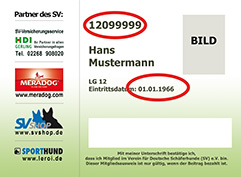How big is the HD/ED problem with German Shepherds? Compared to other breeds in a breed ranking of HD diagnosis, where does the German Shepherd stand?
According to the official statistics of the GRSK (Society for X-ray diagnostics of genetically influenced skeletal diseases of domestic animals), the frequency of HD (C/still admissible, D/medium and E/grave HD) for German Shepherds is with about 8 % in the order of magnitude as for Dobermann, is smaller than for Golden and Labrador Retrievers and Rottweilers, but higher than for Malinois, Schnauzer and Rhodesian Ridgeback.
However, with all these numbers, one cannot assume that they correspond to the HD frequency in the whole population of the individual breed. The above-mentioned pre-selection when sending the X-rays in (or not) is probably not done as consequently for any other breed as it is done for the German Shepherd. Analyses of non-preselected HD X-rays of German Shepherds indicate that the HD frequency in the whole population is probably of at least 25 %.
Regarding ED, the situation with an ED frequency (ED 1/still admissible, ED 2/medium, ED 3/grave ED) of about 9 % in the official statistic presents itself similarly good as for HD. And here, one can truly assume that these numbers are fairly realistic. Because of the more difficult diagnostic, a preselection is far less practiced than it is for HD. The frequency of ED is about in the order of magnitude as for Retrievers and a little lower than for example for Rottweilers. For the German Shepherd, there is a small tendency towards reducing the ED frequency. An acceleration of the breeding progress for ED selection is complicated because of the fact that under the term ED, two different diseases are summarized (isolated processus anconaeus, IPA; fragmented processus coronoideus medialis ulnae, FCP; osteochondrosis dissecans of the elbow joint, OCD) which are passed on differently. For the improvement of the breeding success, a breeding value estimation should be tested which considers the different diseases individually and weights them differently. Scientific preparatory studies regarding this have already been realized with the support of the SV.






